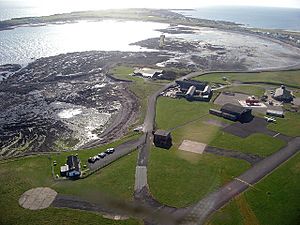Battle of Ronaldsway facts for kids
Quick facts for kids Battle of Ronaldsway |
|||||||
|---|---|---|---|---|---|---|---|
| Part of the Manx revolt of 1275 | |||||||
 |
|||||||
|
|||||||
| Belligerents | |||||||
| King of Mann | Scottish Crown | ||||||
| Commanders and leaders | |||||||
| Godred Magnússon † | John de Vesci, Lord of Alnwick | ||||||
| Strength | |||||||
| ? | ? | ||||||
| Casualties and losses | |||||||
| 537 dead |
? | ||||||
The Battle of Ronaldsway happened in 1275 at Ronaldsway on the Isle of Man. It was a fight between a Scottish army and the local Manx. This battle was the last try by the Manx to bring back their old Norse royal family, known as the Sudreyar dynasty.
The battle ended with the death of the last Norse King of Mann, Guðrøðr Magnússon. Other members of the Manx royal family moved to Norway. This meant that Scotland took firm control of the Isle of Man.
Contents
Why the Battle Happened
The Isle of Man was officially given to Alexander III of Scotland in 1266. But the Scottish rule wasn't always accepted. In 1267, King Alexander had to send soldiers to deal with "rebels" on the island.
Between that time and the 1275 uprising, we only know that Alexander III put his own officials, called bailiffs, in charge of the Isle of Man.
The Manx Fight Back
The Manx people openly rebelled under their leader, Guðrøðr. In response, King Alexander III sent a large fleet (a group of ships) to the island. This fleet was led by John de Vesci and other important Scottish nobles.
The Scottish forces landed on St Michael's Isle on October 7, 1275. They sent a message to the rebels. They offered peace if the Manxmen would stop their "absurd presumption" (meaning their foolish rebellion) and surrender to the King of Scotland.
The Battle Begins
Guðrøðr and the Manxmen refused the peace offer. So, the battle started before sunrise the next day, on October 8. The Manxmen were completely defeated and many of them died.
Guðrøðr likely died in the battle. This ended the male line of the Norse royal family on the Isle of Man. Some people think he might have survived and escaped to Wales, but it's not certain.
What Happened Next
After Guðrøðr's death, Scotland took control of the Isle of Man. This lasted until King Alexander III died in 1285. The island was even listed as a future possession for Alexander's heir, Margaret, Maid of Norway, in 1284.
However, Scotland didn't keep the island for long. By September 1290, Edward I of England was giving orders to the Manx people as their ruler. For many years after that, England and Scotland fought over who controlled the island.
Finally, in 1333, Edward III of England gave up all English claims to the Isle of Man. He recognized William Montacute, 1st Earl of Salisbury as the new King of Mann. But the island was still passed back and forth a few more times between England and Scotland.
In 1343, William de Montacute captured the island with help from the King and was crowned there. English rule was fully brought back in 1399. The title of "King of Mann" changed to "Lord of Mann" in 1504. Then, in 1765, the British Crown bought the title.
Old Graves Found at Ronaldsway
In 1936, the Ronaldsway Aerodrome was being made bigger. Workers were digging into some small hills near the airfield to get soil. When they dug into one hill on the south side, they found many old graves.
To the northeast of these graves, a large number of skeletons were found all mixed up. This old burial mound dated back to at least the 8th or 9th centuries AD. It had been an important strong point in the area. Because of this, people believed the collection of skeletons might be a mass grave of soldiers who died in the Battle of Ronaldsway.
See also

